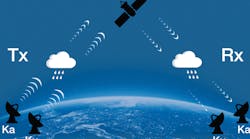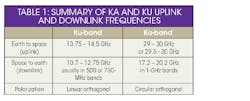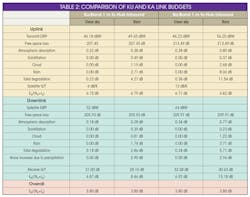Download this article in PDF format.
Although Ka-band satellites have been around for more than 20 years, many early versions did not have commercial services. However, over the last few years, more commercial Ka-band satellites have been launched into space with powerful narrow beams that provide huge throughputs. Table 1 depicts the commercial Ku and Ka frequency bands.
Currently, Ka-band equipment is more expensive due to the high cost of Ka-band microwave power components and the higher accuracies required for waveguides, antennas, and antenna superstructures. Volume manufacturing has started to reduce this cost, making some low-power systems more affordable.
However, Ka-band does present some challenges, many of which can be mitigated by new high throughput satellites (HTSs) or with the proper design of the ground equipment. This article will look at the system impact of channel properties, including propagation and rain degradation.
Satellite Link Design
Simply due to physics, Ku- and Ka-band systems perform differently in terms of propagation loss, rain attenuation, increased noise during rain, low-noise-block-downcoverter (LNB) noise figure (NF), and antenna gains. Some of these differences cancel each other out, while others are mitigated with satellite design, earth station design, and/or link parameters.
The actual satellite design is beyond the control of most satellite-communication link designs. The design of a satellite-communication link is based on a link budget. The link budget defines the transmit effective isotropic radiated power (EIRP) and receive gain-to-noise-temperature (G/T) required to close a link, given design parameters such as availability, data rates, modulation, coding, antenna sizes, block-upconverter (BUC) power, and LNB performance. These parameters affect cost, service-level agreements (SLAs), throughput, and bandwidth requirements, among others. Tradeoffs can be made with various parameters to tailor a solution for a given application.
The following sections present a comparative link budget for discussion. Several properties of the link budget are discussed relative to system performance, including propagation loss, rain attenuation, and the increase in noise due to rain.
Comparative Link Budget
One comparison of Ku- and Ka-band system performance is provided in Table 2, which offers a pseudo real-world example of Ku- and Ka-band link budgets. This link budget is representative of an inbound transmission in which a 1-meter antenna transmits toward a large hub. In this example, the satellite has both Ku- and Ka-band spot beams. These satellite parameters are representative; changes to these parameters can greatly influence system performance. In this example, the overall link availability is 99.5%. The transmit and receive earth stations are co-located in an International Telecommunications Union Rain Region K. The link budgets were prepared using the Satmaster Software.1
Typically, link budgets assume that only one of the uplink or downlink links are affected by rain. The worst case is usually assumed. In the example link budget in Table 2, the overall Eb/(No+Io) is based on an uplink affected by rain, while the rain degradations on the downlink are included for further discussion.
Propagation Losses
A geostationary satellite is located about 36,000 kilometers above the equator, creating a huge propagation loss from the earth station to the satellite. For the earth-to-space link, the propagation loss is about 6 dB worse for Ka-band than for Ku-band. For the space-to-earth link, the propagation loss is about 4 dB worse.
Free-space loss is proportional to the square of the signal wavelength. Antenna gain is also proportional to the square of the signal wavelength. Thus, all other parameters being equal, the increased gain of the transmit and receive earth antennas at Ka-band compensates for this increased free-space loss. In the link-budget example in Table 2, the antenna efficiencies are not the same; Ka-band is assumed to be slightly less efficient as is typical in practice.
Since the gain of the antenna at Ka-band is higher than at Ku-band, smaller antennas are often used. Requirements for a smaller antenna can be the result of application-related size constraints (i.e., COTM applications), portability requirements, or simply cost. For transmitting, a Ka-band antenna, which is half the diameter of a Ku-band antenna, will provide about the same gain as the Ku-band antenna. For receiving, a Ka-band antenna that is about 65% of the size of a Ku-band antenna will deliver similar gain as the Ku-band antenna.
Signal Degradation Due to Rain
Over the years, there have been many studies on rain degradation at Ka-band. Simply put, signal degradation due to rain is much more pronounced at Ka-band than at Ku-band for a given link availability requirement, elevation angle of antenna, and rain region.
In Table 2, the link budget for each of the uplinks and downlinks were specified to have a link availability of 99.75%; the rain region for both transmit and receive earth stations was Rain Region K. The signal degradation would be less in drier environments and in applications where the link availability can be reduced. Conversely, rain degradation will increase in wetter environments, or in cases where the link availability requirement is higher.
Also in Table 2, the signal degradation in the Ku-band uplink due to rain is about 4.3 dB. For Ka-band, the uplink signal degradation is about 11.5 dB. For Ku-band, the downlink signal degradation due to rain is about 2.9 dB; for Ka-band, it is about 5.7 dB.
As noted earlier, overall performance is usually based on the worst-case scenario of uplink or downlink degradation. This is because it is assumed that it will not be raining at both the uplink and downlink sites at the same time. Of course, in the above example, it would be raining at both the uplink and downlink sites, as they are co-located. The link budget was calculated using only the worst-case link, which in this case, is the uplink.
Increase in Noise Due to Rain
In addition to signal attenuation due to rain-related phenomena, the noise seen at the receive antenna increases during rain events. In Table 2, we see the noise increase by almost 3 dB for both Ku- and Ka-band. The atmospheric noise temperature due to rain is independent of frequency and is proportional to the signal attenuation.2 The effect of the rise in noise temperature on link performance is a degraded G/T. The link performance is degraded not only by the attenuation of the received signal, but also due to increased noise temperature.
Note that in the link budget, it was assumed that only the uplink was affected by rain. Therefore, overall Eb/(No+Io) does not include this increase in noise.
EIRP Performance
The transmit EIRP calculated in the link budget is the EIRP required to close the link based on the satellite performance and the design parameters of link availability, coding and modulation, and receive antenna. EIRP is calculated as the BUC transmit power in dBW plus the antenna gain in dBi. Using smaller antennas mean using larger BUCs for the same EIRP. Small antennas with large BUCs may exceed the regulatory off-axis EIRP requirements.
The required system EIRP varies considerably between clear sky and rain fade. In Table 2, the difference between the EIRP required for clear sky and rain fade is about 3.5 dB for a Ku-band system and 10 dB for a Ka-band system. This means for a given antenna size, the BUC power for clear sky is less than half of that required for rain conditions.
For the Ka-band system, the BUC power required at clear sky is about one-tenth of that required for a faded condition. Designing for faded conditions would require a much larger BUC. For example, in Table 2, an 8-W BUC is required for the Ka-band faded condition. In contrast, the same link performance can be achieved in clear sky with less than 1 W. A drawback of using a larger BUC is that without uplink power control (ULPC), the link may use a larger percentage of the satellite transponder power than the percentage of transponder bandwidth. Thus, the user would need to pay for this power-equivalent bandwidth, resulting in increasing operating costs.
Receive G/T
On the receive side, the system performance is determined by the G/T, which includes the receive antenna gain (G) and the system noise temperature (T). The system noise temperature includes contributions from antenna noise temperature and the LNB noise temperature or NF. A “good” Ku-band LNB has a NF of about 0.7 dB. For Ka-band, it would need to have a NF of about 1.3 dB to be considered “good.” Typical LNB NFs at Ku-band are 0.7 to 0.8. At Ka-band, they are typically 1.3 to 1.6 dB.
For the same size antenna, antenna noise temperature is higher at Ka-band. The additional gain of the antenna means G/T for the same size antenna is usually better than the Ku-band antenna despite the higher NF and antenna noise. Table 3 compares the clear sky G/T between Ku- and Ka-band systems.
The Ka-band G/T in clear sky is 1.2 dB better. This result implies that if the Ku- and Ka-band signal at the receive antenna are the same, the Ka-band system Eb/(No+Io) would be 1.2 dB better. This margin could be used to increase throughput by almost 33% at the expense of bandwidth. More throughput in the same bandwidth could also be achieved by employing a more efficient modulation/coding scheme in the system design. Conversely, the designer may use less bandwidth with a more efficient modulation/coding scheme and maintain the same throughput, thus decreasing the operating costs.
As discussed, a decrease in antenna size to approximately 65 cm for the Ka-band system would provide about the same receive gain, but would reduce the system G/T. Table 4 compares the G/T for a one-meter Ku-band antenna and a 65-cm Ka-band antenna.
For a typical inbound link, the G/T of the receive earth station is not usually a problem and does not limit the link budget. However, on the outbound, systems are often receive-limited, meaning that the receive antenna G/T limits the performance of the link. Receive G/T can be improved with larger antennas, reducing losses between the antenna and LNB, and to some extent by utilizing LNBs with better NF. While it is difficult to reduce the LNB NF below 0.7 dB for Ku-band and 1.3 dB for Ka-band, screening of LNBs can be used to improve NFs.
The receive G/T limitations can also be overcome with additional transmit EIRP. However, the added transmit power may require additional satellite power, thus making the whole link more expensive. That’s because the space segment cost will be based on the power-equivalent bandwidth rather than the occupied bandwidth.
What Does This Mean?
Ka-band systems can provide high throughput using smaller terminals, but they suffer from rain degradations much more than that experienced by Ku-band systems. For the same size antennas, the additional gain at Ka-band mitigates the additional free-space loss. Modern HTS satellites offer high G/T and EIRP that eases the EIRP and G/T requirements at the earth stations. However, designing a system to meet a given link availability means the system must be designed for this worst case, resulting in additional cost or size relative to clear-sky conditions, especially for Ka-band.
If the link quality and SLA can vary, degradations due to rain can be lessened by:
- Adaptive modulation and coding
- Reduced throughput
- Reduced bit-error-rate (BER) performance (more errors)
Each of these techniques either lowers the transmitted information rate or increases bandwidth, or otherwise reduces link availability.
Large hub earth stations can help on the inbound by eliminating any receive limitations. Increasing earth-station size, resulting in higher G/T, has diminishing returns in terms of link-budget performance.
ULPC will mitigate transponder power used during clear skies and should reduce operating costs. ULPC does not mitigate the requirement to size the transmit antenna/BUC to meet the faded conditions.
Conclusion
Ka-band systems present challenges in terms of link budgets. For antennas of the same size, the increased gain of the earth-station antenna for Ka-band compensates for the additional propagation losses.
In clear sky, Ka-band systems generally outperform Ku-band systems, at least in terms of requiring less EIRP for the same bandwidth. This is mostly due to the increased performance of Ka-band satellites. However, rain fades for Ka-band must be mitigated with more transmit power or some form of adaptive coding/modulation that reduces the data rates but increases the coding gain.
Michael Schefter is Chief Scientist at Norsat International.
References
1. Satmaster Pro Mk9.1a.
2. JPL D-32584, “Atmospheric Noise Temperature Induced by Clouds and Other Weather Phenomena at SHF Band (1-45 GHz),” Christian Ho, Stephen Slobin, Kelly Gritton, Jet Propulsion Laboratories, 11 August 2005.





